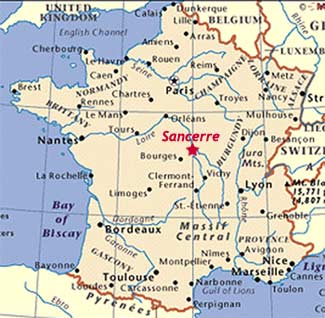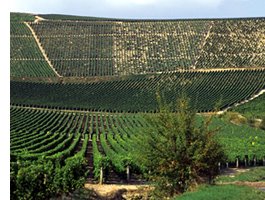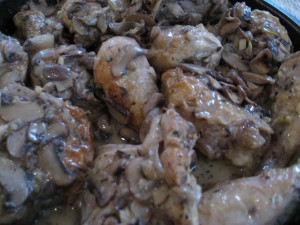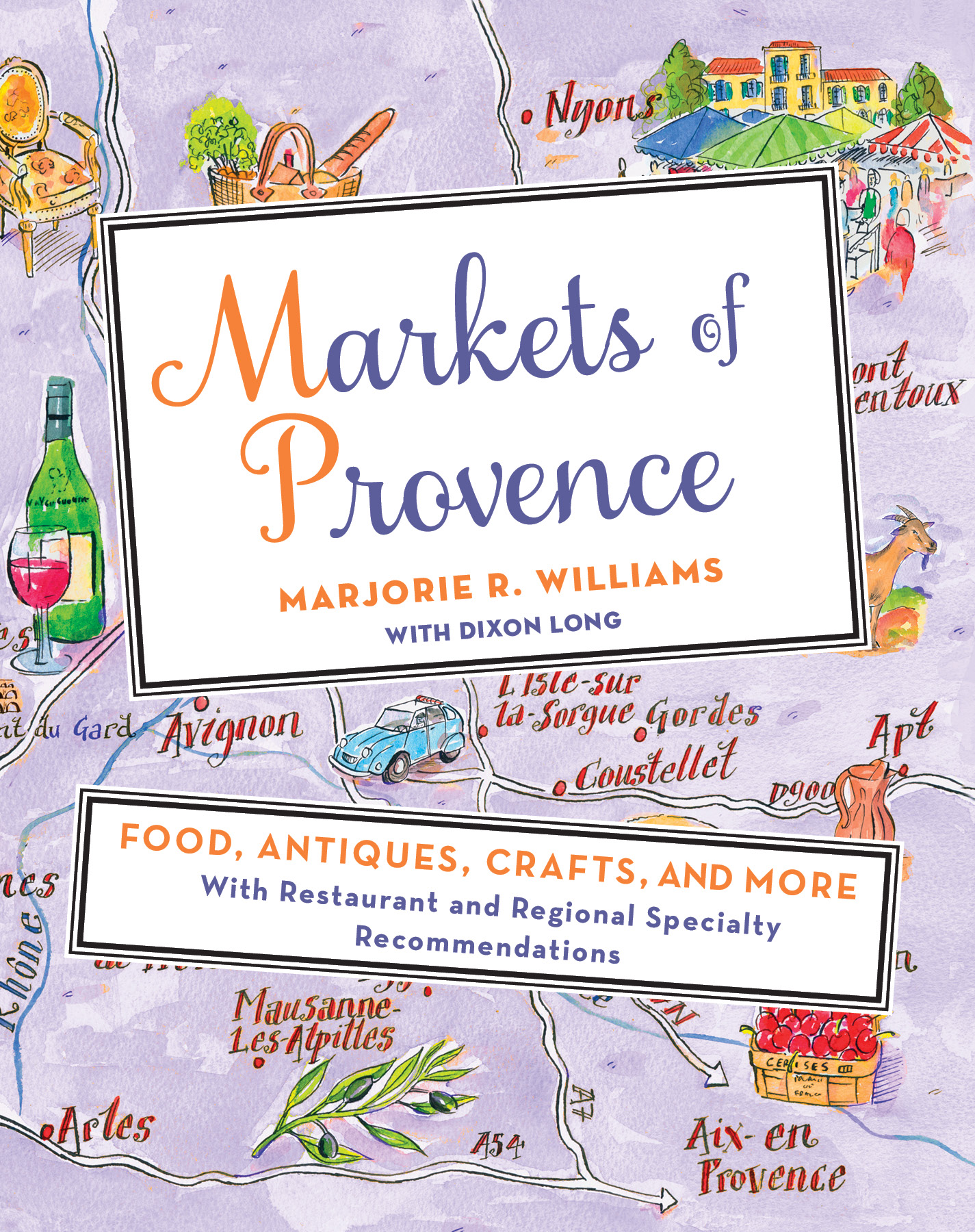The victor, with 45% of the votes, in June’s French Revolution “French Wine” poll is…
Sancerre!
 Congratulations to all you Revolutionaries who chose the French white. In the spirit of fraternité, egalité, and liberté, I’m glad you exercised your right to vote. Read on to find out more about Sancerre, my favorite white wine, and for the monthly poll recette:
Congratulations to all you Revolutionaries who chose the French white. In the spirit of fraternité, egalité, and liberté, I’m glad you exercised your right to vote. Read on to find out more about Sancerre, my favorite white wine, and for the monthly poll recette:
Chicken with Sancerre, Mushrooms, and Thyme
I recently bought a book of Roald Dahl’s short stories. Most of us revere Roald Dahl as the author of classic children’s books, from Fantastic Mr. Fox to Matilda, but he also wrote great handfuls of “mature” stories, stories that are sexy, racy, irreverent, and, above all, intoxicating, like “Taste,” in which the fate of a young girl rests on the outcome of a blind wine taste test. The wine is described as gentle, demure, and bashful. Not a Sancerre.
Knowing about wine is certainly a matter of pride; even if you don’t care much about wine except for its taste and its heady effects, you still feel like you’ve won a culture contest when you can hold up a wine list and at least look like you know what you’re talking about, and come up with some anthropomorphizing adjectives that reconstruct the flavor of the wine in the form of a tantalizing young Bacchanal.
Truth be told, my friend Julie introduced me to Sancerre. She was sitting across the table from me in that mythical, late Moules Frites haven La Tour that I mentioned in Flex!. “Mmm…Sancerre. We’ll have two glasses.”
 In the vein of Roald Dahl’s “tasteful” language, I would describe Sancerre as fruity and flowery all at once, sparkling without the bubbles, the brighter citrus Champagne of flat wines. If she were a Bacchanal, Sancerre would have orange blossoms streaming from her hair and would dance the Charleston. Gentle, demure, bashful she is not; but she is gilded class in a glass. She is witty and elegant, wears almost too many ropes of chic white pearls, and always has the last word.
In the vein of Roald Dahl’s “tasteful” language, I would describe Sancerre as fruity and flowery all at once, sparkling without the bubbles, the brighter citrus Champagne of flat wines. If she were a Bacchanal, Sancerre would have orange blossoms streaming from her hair and would dance the Charleston. Gentle, demure, bashful she is not; but she is gilded class in a glass. She is witty and elegant, wears almost too many ropes of chic white pearls, and always has the last word.
Sancerre is made from the Sauvignon Blanc grape, growing around the town of Sancerre in the Loire Valley. Sancerre is one of the original Appellations d’Origine Contrôlée awarded in the late 1930s—AOC is a way that the French government recognizes and regulates the point of origin of French food products, and is why so many of them are recognized by the name of their town of production, beginning with Roquefort, a blue cheese named after its city, in the fifteenth century. Red and even rosé Sancerres are made in the same region from the Pinot Noir grape.
 Like the life of any party, Sancerre gets along very well with almost anyone, or anything, on the table. But to show her to advantage, I’d sit her with goat cheese to her left and shellfish or whitefish to her right. And if you find you can only take such a spirit in small doses, make a Sancerre spritzer. Giada de Laurentiis makes a brilliant white wine spritzer by freezing orange and lemon zest into ice cubes, and then mixing with sparkling water and white wine. Replace Pellegrino with Perrier and Pinot Grigio with Sancerre. Finally, she’ll sparkle as she was meant to.
Like the life of any party, Sancerre gets along very well with almost anyone, or anything, on the table. But to show her to advantage, I’d sit her with goat cheese to her left and shellfish or whitefish to her right. And if you find you can only take such a spirit in small doses, make a Sancerre spritzer. Giada de Laurentiis makes a brilliant white wine spritzer by freezing orange and lemon zest into ice cubes, and then mixing with sparkling water and white wine. Replace Pellegrino with Perrier and Pinot Grigio with Sancerre. Finally, she’ll sparkle as she was meant to.
To taste! Chin chin!
Please vote in the July poll: which French colonial cuisine do you prefer? Creole/Cajun with its New Orleans beignets? Moroccan tagines and fragrant teas and salads? Quebecoise poutine? Or the salty sweet noodle dishes of Indochine? At the end of July, I’ll share a recipe from the winning cuisine! Oooh…which to choose? They’re all so good! I’ll let the Revolutionary public decide.
- 12 pieces of dark meat chicken (legs and thighs)
- 500 grams of chestnut mushrooms, sliced (use cremini if you cannot find chestnut)
- 4 shallots, sliced
- 3 cloves of garlic
- ¼ cup of olive oil
- 1 tablespoon of butter
- 8 sprigs of thyme
- 1 cup of Sancerre
- 1 cup of chicken stock
- ¼ cup of cream
- ¼ cup of chopped fresh flat leaf parsley
- Salt and pepper
- Herbs de Provence
Procedure
- Start by seasoning the chicken on both sides with salt, pepper, and a light sprinkling of herbs de Provence.
- Working either in batches or using 2 wide pots, heat the olive oil on medium high heat. When the oil is hot, brown the chicken on both sides, and set aside.
- Add the butter to the pot(s), and then the shallots. Sauté for one minute before adding the mushrooms and the thyme. Season with pepper, but hold off on the salt until the mushrooms have achieved a bit of color.
- When the mushrooms are about halfway cooked, and a bit seared, add the Sancerre. Allow the flavor to concentrate for a minute before adding in the stock. Bring to a simmer and lower the flame; then add the chicken back into the pot. Cover, and simmer for 30 minutes, until the chicken is cooked through.
- Take the pot off the heat and stir in the cream and the parsley. Serve with crusty baguette or egg noodles, like in Alsace.







Hi Revolutionaries! I’m really excited about this monthly poll–I love checking to see what you all preferred, and I think it’s a great way to be interactive with French Revolution, which I do encourage with all my heart. Let me know what you think! Why do you love Sancerre? What did you love about Champagne, or Cotes du Rhone, or Cotes de Provence? And how do you feel about the colonial cuisines? Moroccan? Quebecoise? Indochinoise? or Creole/Cajun? Bavardez un peu!
Ah… tu sais les Québécois n’apprécieront pas la qualification «coloniale» à leur cuisine. La maxime «Je me souviens», la devise du Québec, fait entre autre référence au fait que la France a qualifié la «colonie» de quelques 100 arpents de neige. La soif d’indépendance de tout joug est fondamentale à l’âme québécoise. Certes, nous avons des tourtières, des cretons, des chaudrées, but it’s incidental ;-P
Merci, Louise, for your comment. You bring up a very important point, one that I think applies not only to Quebec, but to the other three locations I mentioned in this month’s poll, and many more francophone places around the world. As an American, I understand the love of freedom and the pride in independence, and I know that Quebec in particular, being one of my favorite regions of the Americas and the home of much of my family, is especially loving and proud of these things. I certainly, I’m sure you know, had no intention of offending with the term “colonial,” I only meant it as a descriptor that would be easily understood, for, after all, Morocco was a protectorate, not a colony, and New Orleans is simply the site of much francophone migration. Perhaps the term was incorrect all around, but I must say, that whatever the past may be, however difficult the history, the cuisine of what I call “francophone fusion” is fruitful, and I am glad for it. Whatever else French imperialism may have inflicted on certain parts of the world, I do not think that culinary influence was for the worse, and the results are a delicious historical testament to the many hands of the many chefs that stirred the pot in Canada, the American South, North Africa, and Vietnam.